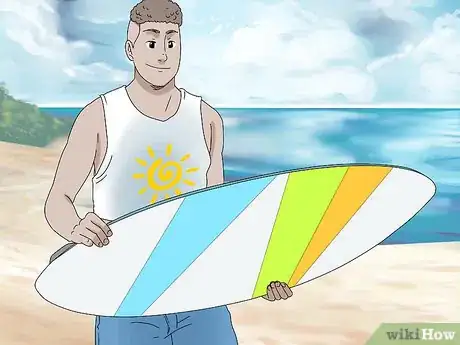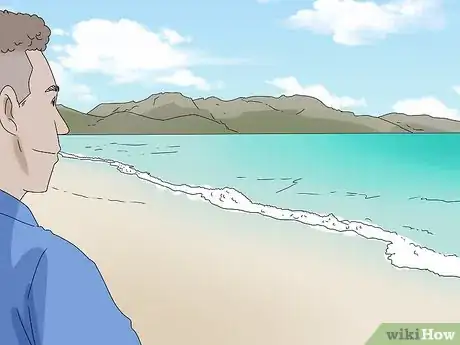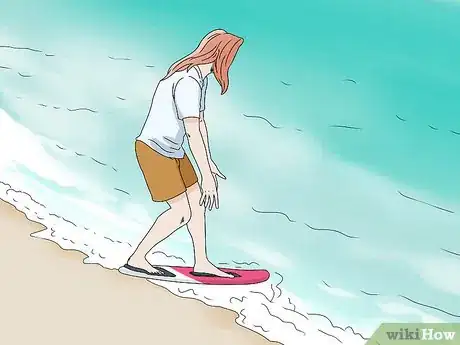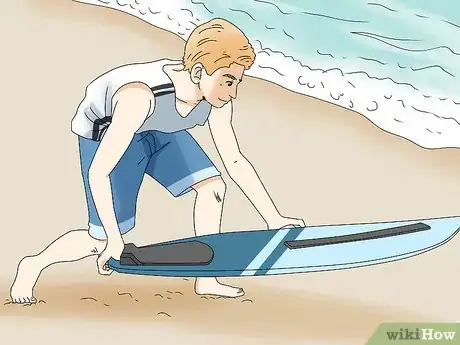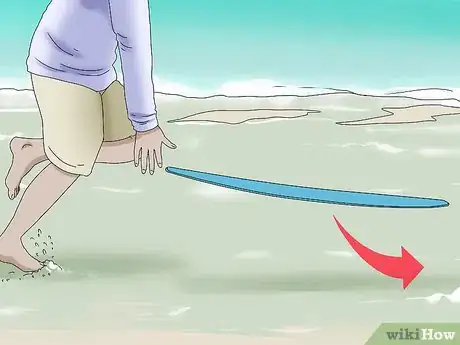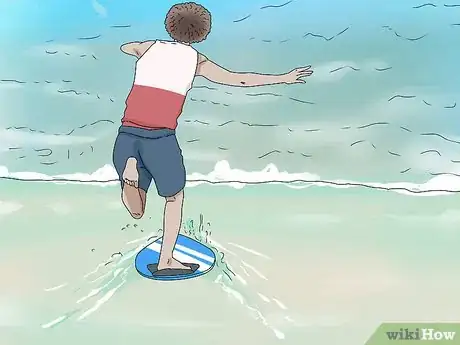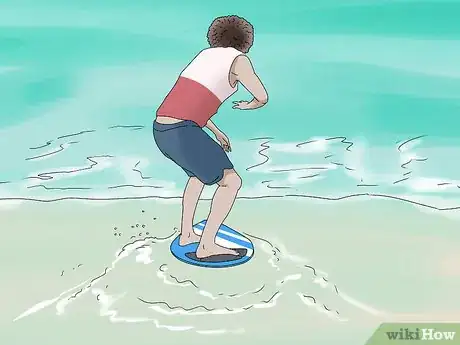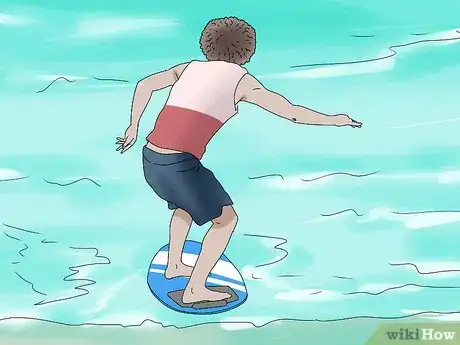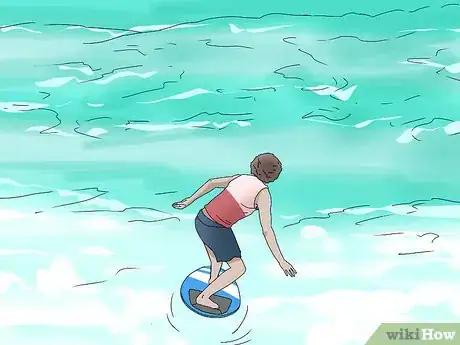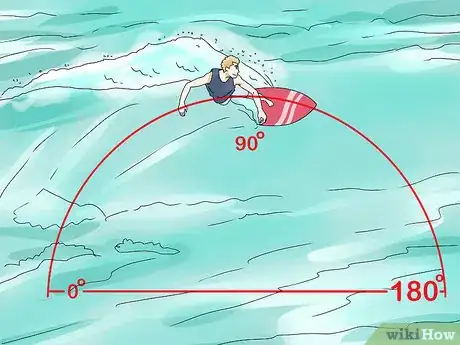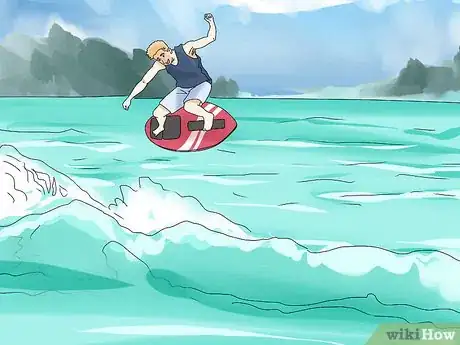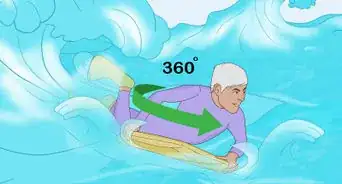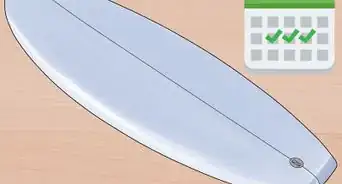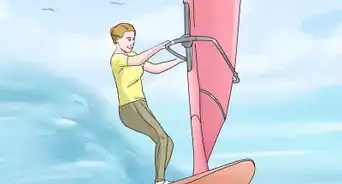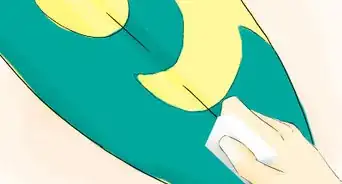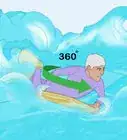This article was co-authored by wikiHow Staff. Our trained team of editors and researchers validate articles for accuracy and comprehensiveness. wikiHow's Content Management Team carefully monitors the work from our editorial staff to ensure that each article is backed by trusted research and meets our high quality standards.
wikiHow marks an article as reader-approved once it receives enough positive feedback. In this case, 86% of readers who voted found the article helpful, earning it our reader-approved status.
This article has been viewed 311,273 times.
Learn more...
Skimboarding is one of the most fun and increasingly popular sports in the world. In skimboarding, you use a skimboard (essentially a small, finless surfboard) to glide across sand or water and ride waves. If you’ve never tried skimboarding before, the sport may seem a little intimidating at first. However, by getting the right skimboard for you, finding a good spot, and mastering basic skimboarding techniques, you can learn how to skimboard in no time!
Steps
How to Find the Right Board and Location
-
1Buy a small, flat, wooden board if you’re mostly going to sand skim. It’s generally easier to skimboard on sand than on the water, so you’ll probably want to do this first if you’re just starting out. Sand skimming only requires a board with a flat design, which most wooden boards have. Plus, wooden boards are usually cheaper than foam boards, making them ideal for those who are trying to save money while skimboarding.[1]
- The typical price for a wooden skimboard is around $100.
- You can buy wooden skimboards at most sporting goods stores and many mass retailers.
-
2Opt for a curved foam board to go skimming on water. Once you’ve gotten the hang of skimming on sand and want to try skimming on water, you’ll want to get a skimboard that isn’t as heavy as your sand skimming board. Foam boards are much lighter than wooden boards, making them ideal for skimming over water. They also typically are made with a curved design that makes it easier for the skimmer to ride along breaking waves.[2]
- The typical price for a foam skimboard is around $200, though some may be as much as $600.
Advertisement -
3Find a flat beach along the coast to skimboard on. The best terrain to go sand skimming on is any beach with smooth, flat sand. For skimming on water, the most important thing to look for is a shoreline with a very powerful shore break, meaning it produces sizable waves that you can ride all the way back to shore.
- If you want to focus mainly on wave skimming instead of sand skimming, then it might be better to go to a beach with a steep slope.
- Some of the more popular beaches to skim at are located in San Diego, England, and Florida.
-
4Make sure you’re able to run and jump without any physical issues. Skimboarding is a strenuous sport; if you’re not in shape, you may injure yourself doing it. Don’t try skimboarding unless you’re sure you can run in short spurts, ride on a board, and take a few falls during the learning process.[3]
- Keep your leg and back muscles stretched, warm, and strong while you’re learning to skimboard to avoid injury.
How to Master the Basics
-
1Lean forward and hold your board about 6 inches (15 cm) above the sand. This is the starting position for both sand skimming and wave skimming. Stand with the water on your left side if you’re right-handed and vice versa.[4]
- While you’re holding the skimboard, put 1 hand on the back tail and 1 hand on the side rail halfway up the board.
- Hold the board so that it’s parallel to the ground. One of the most common mistakes in skimboarding is pointing the board upwards before you throw it, which will result in a significantly slower skim.
-
2Throw the board out in front of you when the sand is wet. The best time to throw the board is when there’s a thin coating of water on the sand between 0.25 inches (0.64 cm) and 0.5 inches (1.3 cm) high. If you’re sand skimming, throw the board just as a wave is being sucked back out into the ocean. If you’re skimming the water, throw it just before a wave comes in.[5]
- Make sure you throw the board parallel to the shoreline to give yourself a longer ride.
- You can also opt to get a running head start before you throw the board, in order to pick up more speed. However, this isn’t strictly necessary if you can throw the board hard enough.
- When you’re just starting out, practice throwing the board from the starting position a few times to get the feel of it down and to learn how hard you need to throw it.
-
3Run onto the board rather than jumping onto it after you throw it. If you jump or hop onto a moving skimboard, you’ll immediately faceplant. Instead, run up to and alongside the board at an even pace. Place your front foot just slightly past the middle of the board, then place your back foot behind it.[6]
- Using this method ensures that the board loses no speed as you get onto it (whereas if you jump onto it, the board is forced to break the surface tension of the water and thus stops skimming).
- Aim to take about 3 running steps before you jump onto your skimboard.
- Do not push off hard with your first foot when getting on the board; this will make the board shoot forward and fly away from you.
- Be sure to wear a helmet the first few times you try to run onto the board, just in case you fall off the board. It’ll be difficult to learn how to run onto the board without falling, but you’ll be able to master this move with enough practice!
-
4Keep your knees bent and your weight centered on the board. This is the ideal stance to be in on your skimboard in order to maintain balance and not fall off. Put slightly more pressure on your front foot if you’re sand skimming. If you’re skimming on water, put more pressure on your back foot just as the board makes contact with the water so that the front of the board doesn’t catch on it.[7]
- Maintaining a low stance on the skimboard is also a good technique for staying balanced while skimming.
- Your knees not only play an important role in skimboarding, but they’re also one of the more at-risk parts of your body when you’re skimming. Stop skimboarding immediately if your knees start to hurt to avoid giving yourself a serious injury.
-
5Maintain your balance until the board stops or shift your weight to turn. Whether your sand skimming or skimming on water, the act of riding a skimboard is mostly about staying on the board until it stops on its own. If you want to turn to change directions, simply shift your weight slightly to the side that you want to be turning towards.[8]
- You generally won’t need to turn much if you’re sticking to sand skimming. However, turning is essential for riding waves and performing most tricks.
How to Learn Popular Tricks
-
1Skim onto a breaking wave to ride it. Throw down your board and begin skimming toward the wave from a side angle as it starts to break. When you’re on the crest of the wave, use your back foot to turn the board so that you’re pointed toward the shore. Then, ride the wave back to shore.
- Bend your knees when you’re at the bottom of the wave to help keep your balance.
-
2Try a 180-degree turn to add a more complex trick to your repertoire. To complete a 180-degree turn, rotate your hips in the direction you want to turn. Then, while keeping your feet firmly on the board, swing your back leg toward your back, following the same direction that you turned your hips in. Finally, continue turning your hips so that you’re pointed in the opposite direction.[9]
- Although it sounds simple, it’s a bit more complex to physically perform, so don’t try it unless you’ve gotten the hang of turning on a skimboard.
- Once you’re able to perform a 180-degree turn, try spinning the skimboard all the way around to do a 360 turn!
-
3Jump and spin above the skimboard to perform a body aerial. Body aerials are another very popular trick that most skimboard beginners can learn to do with a little practice. Once you’re skimming at full speed, jump upwards off the board with both feet and spin once in the air. To successfully complete the trick, land back on the skimboard while maintaining your balance.[10]
- Although the full trick involves landing back on the board, even being able to jump and spin above your skimboard is pretty impressive.
Community Q&A
-
QuestionShould I add wax if my board has some type of gripping?
 Parker FentonCommunity AnswerNo, because the gripping is there as a replacement for the wax.
Parker FentonCommunity AnswerNo, because the gripping is there as a replacement for the wax.
Warnings
- You can use traction pads to avoid falling off your board, although these are not recommended for beginners. A traction pad is a permanent rubber pad that you stick to the deck, which allows you to keep your footing without falling.⧼thumbs_response⧽
- To reduce your risk of drowning, avoid skimboarding in deep water while you’re still a novice. Practice sand drops and basic sand-skimming at first.⧼thumbs_response⧽
- Don’t skimboard in conditions that you’re not comfortable with. If the waves look too big or powerful for you, for example, don’t go for them.⧼thumbs_response⧽
References
- ↑ https://www.thrillappeal.com/how-to-skimboard
- ↑ https://www.thrillappeal.com/how-to-skimboard
- ↑ https://www.surfertoday.com/skimboarding/the-basic-and-most-useful-skimboarding-tips-and-techniques
- ↑ https://www.thrillappeal.com/how-to-skimboard
- ↑ https://www.thrillappeal.com/how-to-skimboard
- ↑ https://www.thrillappeal.com/how-to-skimboard
- ↑ https://www.mh.co.za/guy-skills/how-to-skim-board/
- ↑ https://www.thrillappeal.com/how-to-skimboard
- ↑ https://www.thrillappeal.com/how-to-skimboard
About This Article
To skimboard, start by leaning forward and holding your board 6 inches above the sand so the sand and your board are parallel. If you're right-handed, the water should be on your left side, and vice versa. Next, throw your board out in front of you just as a wave is being sucked back out or right before a wave comes in. Then, right after you throw your board, run onto it, keeping your knees bent and your weight centered. As you're riding the board, keep your weight low to help yourself maintain balance, and shift your weight in the direction you want to turn in. To learn how to do popular skimboarding tricks, scroll down!
